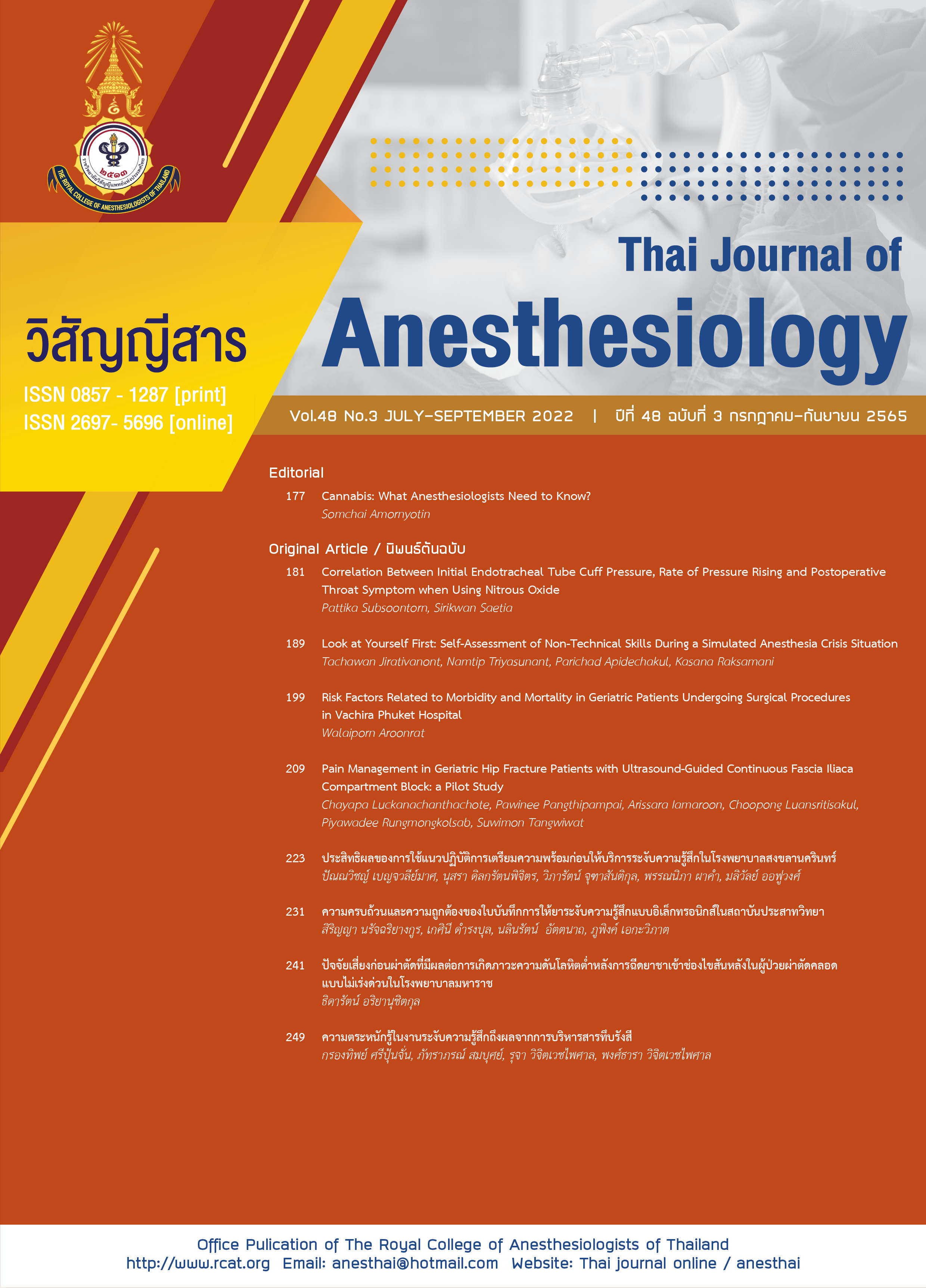An Intuitive Anesthesia Awareness of Contrast Media Administration
Main Article Content
Abstract
Contrast media, an iodinated compound, is applied in diagnostic and interventional radiology. It helps the physicians correctly visualize the internal organs and effectively diagnose the abnormalities. In the limited situation, anesthetic personnel become a part of management team. Contrast media has some medicinal properties. Physicians should take a careful approach in patients with asthma, allergy to drugs or seafood, high serum creatinine, children below 1 year of age or under the weight, women with gestational age less than 4 months and patients continuing treated with radioactive iodine. Allergy to contrast media is a state of emergency. Concealed by anesthesia, patients’ signs and symptoms develop insidiously with skin lesion up to severe episode such as anaphylaxis or anaphylactoid reaction, which resulting in the loss of life. Treatments have to begin with opening patients’ airway, breathing with 100% oxygen, supporting hemodynamic and cardiac function, resuscitation and continuing care in the intensive care unit.
Article Details

This work is licensed under a Creative Commons Attribution-NonCommercial-NoDerivatives 4.0 International License.
References
Suriyajakryuththana W, Suppakool N. Practical points for using contrast media. Vajira Med J. 2015;59:73-80.
ชนินทร์ เอื้อวิไลจิต. รังสีวิทยาหลอดเลือด. กรุงเทพฯ: โฮลิสติก พับลิชชิ่ง จำกัด, 2542.
Neuaithong K. Prevention guidelines for reduction adverse reaction from intravenous administration of iodinated contrast medium (ICM). Srinagarind Med J. 2009;24:91-101.
นายแพทย์บัณฑิต เจ้าปฐมกุล. คู่มือแนะนำการใช้ยาอย่างสมเหตุผลตามบัญชียาหลักแห่งชาติ สารช่วยการวินิจฉัยโรคด้านรังสีวินิจฉัย. กรุงเทพฯ: อักษรกราฟฟิคแอนด์ดีไซน์, 2559.
Cohan RH, Ellis JH, Dunnick NR. Use of low-osmolar agents and premedication to reduce the frequency of adverse reactions to radiographic contrast media: a survey of the Society of Uroradiology. Radiology. 1995;194:357-64.
Yuwanim N. The adverse reaction after intravenous administration of contrast media in intravenous pyelography. Med J Srisaket Surin Bureram Hosp. 2009;24:335-43.
Morcos SK. Contrast media-induced nephrotoxicity-questions and answers. Br J Radiol. 1998;71:357-65.
Khamtuikrua C. Anaphylaxis in anesthesia practice: a review. Thai J Anesthesiol. 2015;41:189-201.
Brockow K. Skin test in patients with hypersensitivity reactions to iodinated contrast media- a European multicenter study. Allergy. 2009;64:234-41.
คณะทำงานเพื่อการรักษาและป้องกันการแพ้ชนิดรุนแรงแห่งประเทศไทย. แนวทางเวชปฏิบัติสำหรับการดูแลผู้ป่วยที่มีการแพ้ชนิดรุนแรง พศ. 2560 (Clinical Practice Guidelines for anaphylaxis 2017). [citied 2020 Dec 12]. Available from: URL:Thai_CPG_Anaphylaxis_2017_Full_version.pdf (allergy.or.th)
Morcos SK. Barium preparations: safety issues. In: Thomsen HS, Webb JAW., editors. Contrast media: safety issues and ESUR guidelines. 3rd ed. Berlin: Springer, 2014; p.239-42.
Chaopathomkul B, Ruxrungtham K, Leelanukrom R, et al. Clinical practice guideline for contrast media administration in diagnostic imaging. Chula Med J. 2010;54:375-90.
Mohammed NMA, Mahfouz A, Achkar K, Rafie IM, Hajar R. Contrast-induced nephropathy. Heart Views. 2013;14:106-16.
Katzberg RW. Iodinated contrast media for urological imaging. In: Pollack HM, McClennan BL, editors. Clinical urography. 2nd ed. Philadelphia: W.B. Saunders, 2000; p.19-43.
Nueaithong K. Adverse reaction from intravenous administration of iodinated contrast material in patient undergoing intravenous urography. Srinagarind Med J. 2012;27:288-96.
Anaphylaxis from Wikipedia, the free encyclopedia. [citied 2020 Dec 12]. Available from: URL: Anaphylaxis-Wikipedia


